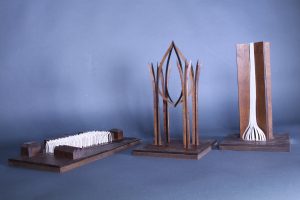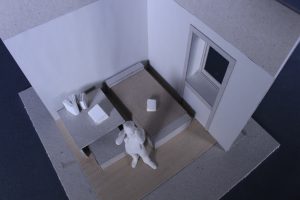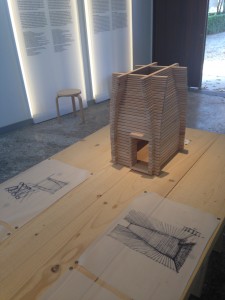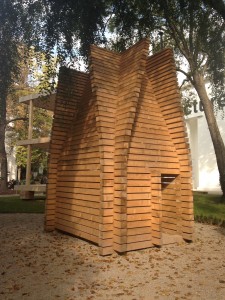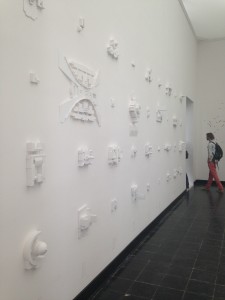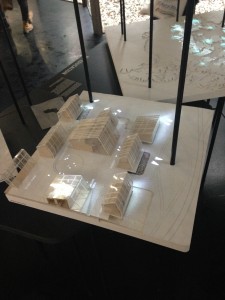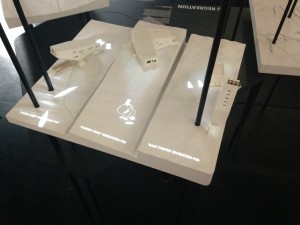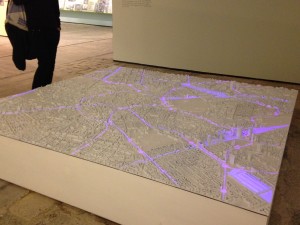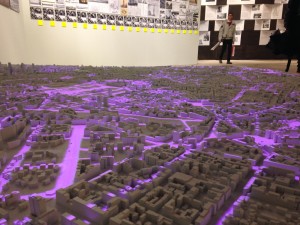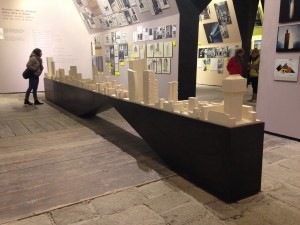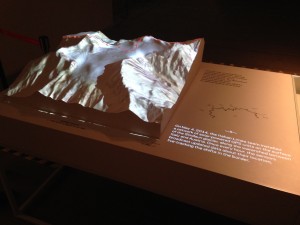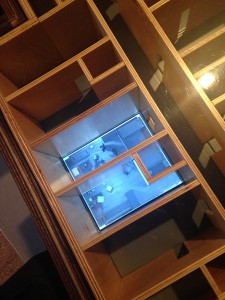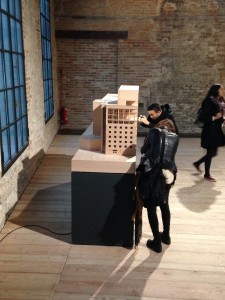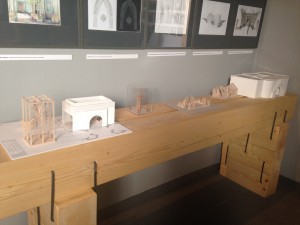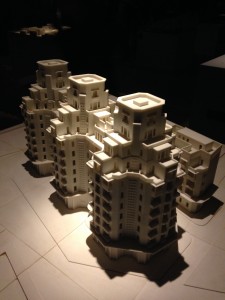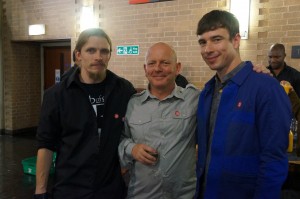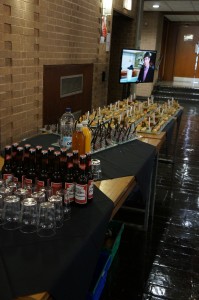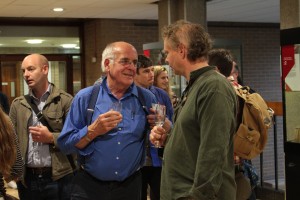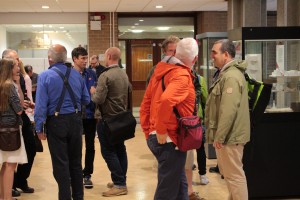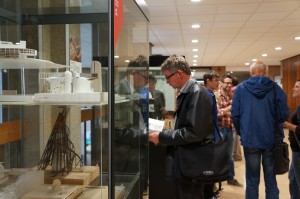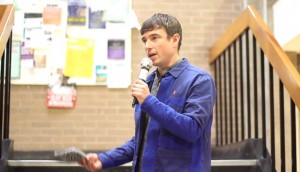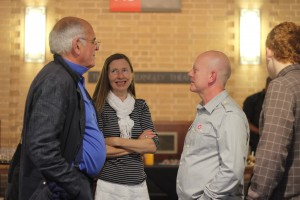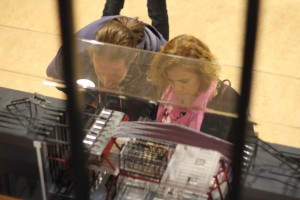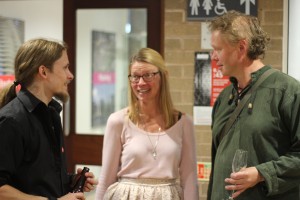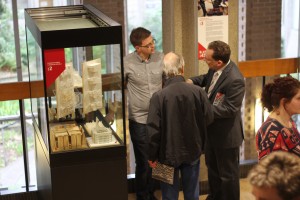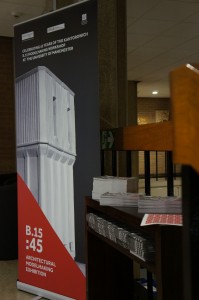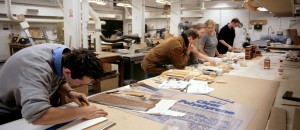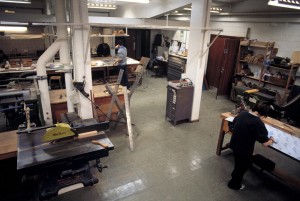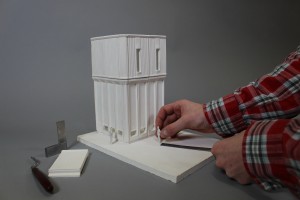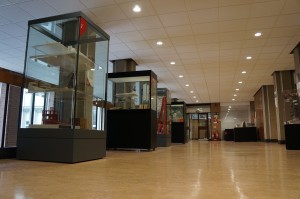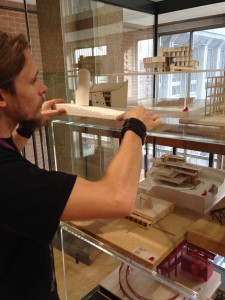Tag Archives: Exhibition
Exhibition: ‘Sun, Sea and Modelmaking – Atelier La Juntana 2019’ November 18th-29th
We’re pleased to announce the second event in conjunction with our 50th Anniversary celebrations:
An exhibition of student work from the third MSA exclusive week with Atelier La Juntana which took place in July 2019. The exhibition has been curated by Saul Parker-Backhouse at B.15 Modelmaking workshop and will present the full range of craft outputs from the week-long course along with video and process descriptions.
Launch Presentation Evening – Thursday November 28th from 18.00
Join us for a presentation by ALJ course organiser Armor Gutierrez Rivas who will be presenting the course and discussing how MSA students can take part in next years course.
The exhibition will take place in the foyer of Humanities Bridgeford Street Building between November 18th and 29th and both the presentation evening and exhibition are free to attend.
‘Celebrating Burnage Garden Village: Building Manchesters Pioneering Housing’ Exhibition
Senior Workshop Technician Jim Backhouse recently completed two vintage style models for the upcoming exhibition ‘Celebrating Burnage Garden Village: Building Manchesters Pioneering Housing’ which will open with a launch event this coming Saturday at Manchester’s Central Library.
The two models show the overall estate plan at 1:500 along with a 1:100 model of a semi-detached house. Jim’s modelling style took inspiration from the original plans and drawings from the early 20th century hand finishing components using water colour.
- Burnage Garden Village in the early 20th Century
- 1:100 Semi-Detached House Model
Exhibition Launch description:
Burnage Garden Village, built 1908-1910, is an little gem, with architectural influences from Raymond Unwin and other Arts and Crafts enthusiasts. It is still managed by a local committee of Manchester Tenants Ltd established in 1906. Come to the launch of a small exhibition detailing the design and building of this pioneering Garden Village here in Manchester, hear about how it attracted socialists, suffrage campaigners and conscientious objectors as well as some extraordinary artists, sculptors and explorers.
Opening at Manchester Central Library this Saturday, March 2nd and running for the duration of March.
Tickets for the opening event are free and available here: https://www.eventbrite.co.uk/e/celebrating-burnage-garden-village-building-manchesters-pioneering-housing-tickets-55917194835
WHAT WE DO HERE to Feature at “TIME SPACE EXISTENCE” Exhibition, Venice Biennale
We are pleased to announce that following our June 29th Premiere and debate of WHAT WE DO HERE, the film will then take up a 5 month residence at Palazzo Bembo as part of the TIME SPACE EXISTENCE Collateral Biennale exhibition. WWDH will be screened on repeat during all opening hours at Palazzo Bembo between June 30th and November 25th 2018.
“The fourth edition of the biennial architecture exhibition “TIME SPACE EXISTENCE” presents a wide selection of works from architects, photographers, sculptors and universities from all over the world. In addition, projects realized in cooperation with institutions and museums.
The participating architects and artists come from diverse cultural backgrounds and different career stages, i.e. established architects next to professionals whose works might be less known. What they have in common is their dedication to architecture in the broadest sense of their profession. The exhibition shows a vast spectrum of presentations (models, concepts, research outcomes, thoughts, dreams and ideas), placing classical architectural installations in dialogue with surprising artistic elements.
The topic TIME SPACE EXISTENCE gives the possibility for each architect to focus on these fundamental existential questions, creating an extraordinary combination of projects and approaches. By combining projects from architecture studios with works of architecture photography and sculpture, the exhibition becomes a dialogue between current developments, ideas and thoughts in art and architecture, highlighting the philosophical concepts of Time, Space and Existence.” – http://www.palazzobembo.org/
PREMIERE SCREENING AND DEBATE
WWDH will premiere at the Biennale Arsenale Site on June 29th followed by a debate on the subject.
B.15: ARCHITYPES Exhibition
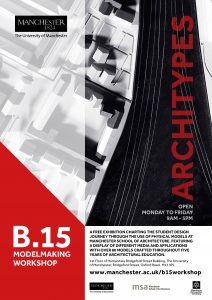 We are very pleased to announce a new modelmaking exhibition of student projects opening September 2016: ‘B.15: ARCHITYPES’
We are very pleased to announce a new modelmaking exhibition of student projects opening September 2016: ‘B.15: ARCHITYPES’
The exhibition charts the different applications of modelmaking used by students of Architecture at the Manchester School of Architecture acting as a point of reference and inspiration in the subject.
Featuring over 80 pieces of varied types and styles from across 5 years of education. The display is supported by a brand new guidebook describing the projects material make-up and context.
Private View Opening
The exhibition will be opened with a private view on Friday 16th September from 17.30 onward. Dr Raymond Lucas will be present to officially mark the opening with a short introduction. This event is free for all so please come and join us in celebration of the subject there will be refreshments provided.
The exhibition will then be open 9.00 – 16.30 Monday to Friday.
Please contact us if you require any further information: scott.miller@manchester.ac.uk
Hope to see you there!
Jim & Scott
Venice Biennale 2014
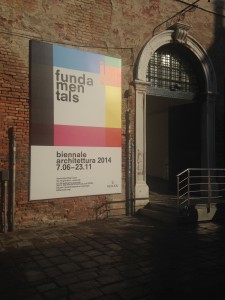 By now there have been hundreds of on-line reviews of the Venice Biennale which is this year focused around Architecture. The Venice Biennale is an annual event that showcases the creative arts from across the globe. Having been open since the start of June this year, the show is almost coming to its end having seen thousands of interested visitors of all backgrounds. My visit last week coincided with the 5th year study trip which basically allowed students free reign over the site and city.
By now there have been hundreds of on-line reviews of the Venice Biennale which is this year focused around Architecture. The Venice Biennale is an annual event that showcases the creative arts from across the globe. Having been open since the start of June this year, the show is almost coming to its end having seen thousands of interested visitors of all backgrounds. My visit last week coincided with the 5th year study trip which basically allowed students free reign over the site and city.
My interest on the site is of course about the varied use of models. There was certainly no shortage of examples. Each international pavilion display addressed their own study of architectural fundamentals and the use of models played a regular and prominent role. As there were so many examples I will summarize my visit by including images of the examples on show and pay particular attention to contemporary methods of display which noticeably inspired many of the students I was with.
Finland – This pavilion was curated in a clear a concise way that explained the concepts in drawings, writing, models and the full size buildings on display outside of the main space. This method of display for the project was great and makes for easy understanding by any visitor. It’s probably worth taking note of this narrative when thinking about the display or presentation of your own projects.
The use of timber pieces accurately cut for the model (above) translated directly into the construction of the 1:1 construction (right).
Austria – Now as popular as they are amongst established architects I’ve never been a huge fan of the ‘White Model’. I’m not sure why but I suppose it feels like a stark and almost clinical representation of a form which in reality has much more texture and thought behind its finish. That said, I’ve made many of these for clients and of course pursue the whitest of white finish to meet their brief. The Austrian pavilion presented a bright white room dotted with white block models of every one of the worlds parliament buildings (above left and below). I thought it was fantastic and enticing as did so many other visitors who spent a substantial amount of time examining the many models on display. This was an interesting subject matter to study in model form due to the ‘god’ like decisions that come from each of these buildings across the globe. One of my favourite displays of the show.
Projection Models – There was a noticeable buzz around the use of projectors to animate aspects of otherwise static models from the students I was with. Whilst this is something we have looked into before there were several good examples used across the Biennale.
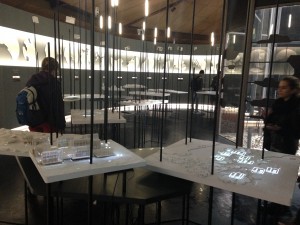 The Canadian pavilion made extensive use of the projection model with micro projectors mounted above white site models. Each model showed traffic flow trends and potential variants in the environment around the site. Anyone wanting to attempt a similar project should start by looking at the type of projector you want to use as they can be expensive and planning their set up in relation to the model is crucial.
The Canadian pavilion made extensive use of the projection model with micro projectors mounted above white site models. Each model showed traffic flow trends and potential variants in the environment around the site. Anyone wanting to attempt a similar project should start by looking at the type of projector you want to use as they can be expensive and planning their set up in relation to the model is crucial.
The Italian pavilion made use of a similar projection set up but was across a master plan model showing city routes toward and around particular hubs of activity.
Also on display in the Italian Pavilion was a host of plaster cast models (right) each with a high level of finish and detail that guaranteed a closer inspection from anyone who walked into the room.
This alpine mountain range model (left) made using a CNC router worked fantastically when OS maps were projected on the the model from directly above. the contouring matched perfectly and appeared almost hologram like in front of the viewer.
Russia – In the Russian pavilion there was an interesting model on show that combined digital animation with a physical model. The basic walls and elevations of the model were built up out of plywood and overlaid on top of screens with animated environments of the proposed interior spaces (left).
Turkey – There was a fantastic presentation cross section model of a theatre which was finished in veneer and full lighting (below). As is usually the case with models of this size they invite you to almost get inside the building and view different perspectives as you choose. This model was one of the best in show in terms of attention to detail and finish quality.
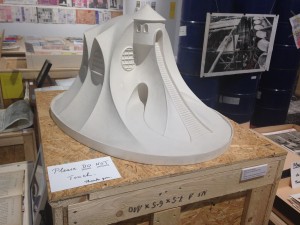 Japan – This display reminded me of a studio workspace with samples from different stages of the design process on display all over the room. Amongst the items were plaster casts (left) and perhaps interesting for our second and third year students at the moment, 1:1 structural details such as this fantastic timber joint detail below.
Japan – This display reminded me of a studio workspace with samples from different stages of the design process on display all over the room. Amongst the items were plaster casts (left) and perhaps interesting for our second and third year students at the moment, 1:1 structural details such as this fantastic timber joint detail below.
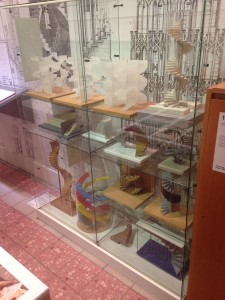
The main ‘Fundamentals of Architecture’ display by Rem Koolhass contained a fantastic array of different design and building components split it to groups and stages of production. One of the rooms featured a wide range of concept models from spiral stair cases (right). These were produced in different materials and at varied levels of finish but all as intriguing to see as each other.
The Hungarian Pavilion featured a number of great drawings and subsequent sketch models (left). These were made from a variety of materials and almost 100% using traditional analogue methods – that means no laser cutting guys! 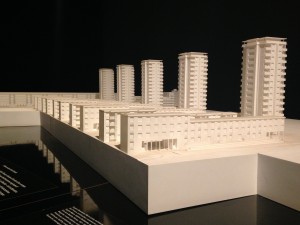
A huge part of the display in the French Pavilion looked at the tower block housing development called Cite De La Muette. The site was a modernist development that became synonymous with sadness after it was converted into a major internment camp for persecuted French Jews awaiting deportation during WW2.
 The exhibition looked at the values and goals the development originally set out to achieve that were unfortunately very short lived. The center piece of the display was a white presentation model of the site with a romanticized film vision of modernist living projected behind (left).
The exhibition looked at the values and goals the development originally set out to achieve that were unfortunately very short lived. The center piece of the display was a white presentation model of the site with a romanticized film vision of modernist living projected behind (left).
Conceptual presentation model on display in the Costa Rican Pavilion (below)
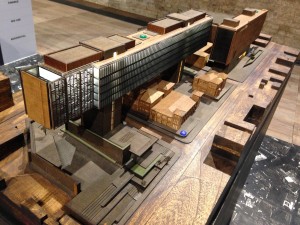 I can’t say I’m a huge fan of the design but this Korean hotel model was finished to a high standard from beech veneer and timber (below). Very nice.
I can’t say I’m a huge fan of the design but this Korean hotel model was finished to a high standard from beech veneer and timber (below). Very nice.
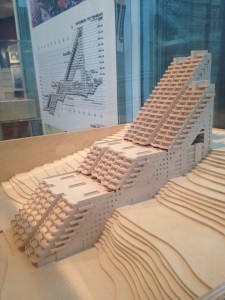 One of the 3d printed models from the Moroccan Pavilion display (below). A series of site models were displayed under spotlights in a sand filled dark room. Quite a strange experience to walk around.
One of the 3d printed models from the Moroccan Pavilion display (below). A series of site models were displayed under spotlights in a sand filled dark room. Quite a strange experience to walk around.
Interestingly, despite its increasing prominence in people’s consciousness both professional and public, the use of 3D printing was thankfully kept to an appropriate level in most cases. I was particularly glad of this as the repeated use of this method of model production can become somewhat boring!
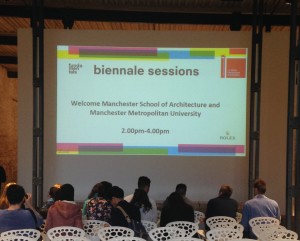
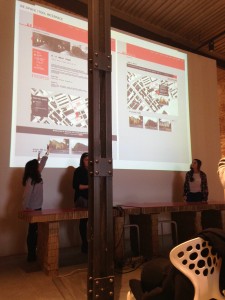 As well as the endless exploring of exhibitions across Venice the visiting students did manage to get a tutorial or two in and a presentation session of their proposed ideas.
As well as the endless exploring of exhibitions across Venice the visiting students did manage to get a tutorial or two in and a presentation session of their proposed ideas.
The show was a fantastic display and I would encourage anyone to visit and see as much of it as possible next time around. The city is, without really needing to say, a fantastic inspiration and learning experience in itself.
Gaudi: Architecture Ahead of its Time Exhibition, Vienna
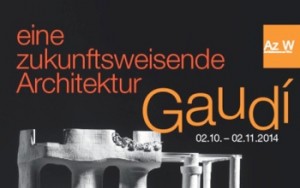 During a recent trip to Vienna I was lucky to catch the last day of an exhibition of the works of Gaudi at the Architekturzentrum Wien. The exhibition consisted of examples of furniture design alongside descriptions, slide shows of the major works and of course models.
During a recent trip to Vienna I was lucky to catch the last day of an exhibition of the works of Gaudi at the Architekturzentrum Wien. The exhibition consisted of examples of furniture design alongside descriptions, slide shows of the major works and of course models.
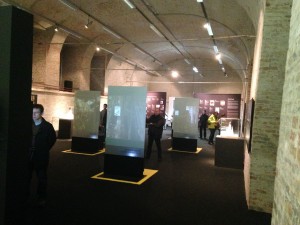 Of particular interest to our cause were the plaster models showing details and sections through parts of his buildings. The quality of these pieces was stunning and the photographs I was able to take really don’t do them justice.
Of particular interest to our cause were the plaster models showing details and sections through parts of his buildings. The quality of these pieces was stunning and the photographs I was able to take really don’t do them justice.
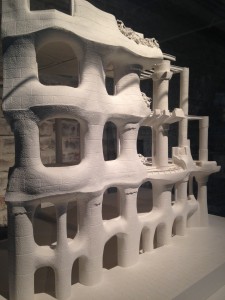 We can take from them is inspiration and a demonstration of the sort of insights models of this type can give us into the form and construction of a building. From my best insights a would say that models have been cast in sections and fitted together afterwards due to the fragility and complex shape of certain details. This method of Modelmaking requires the main focus on planning with a conscious thought for the casting process at all times. Martial tolerance and shrinkage is a key factor in designing parts to a particular size for assembly after casting.
We can take from them is inspiration and a demonstration of the sort of insights models of this type can give us into the form and construction of a building. From my best insights a would say that models have been cast in sections and fitted together afterwards due to the fragility and complex shape of certain details. This method of Modelmaking requires the main focus on planning with a conscious thought for the casting process at all times. Martial tolerance and shrinkage is a key factor in designing parts to a particular size for assembly after casting.  This facade section model of ‘La Pedrera’ in Barcelona shows the layers of supporting structure and outer form beautifully. In addition to the physical properties of the building demonstrated through the design, the shadows cast through window openings clear and defined giving accurate projections of how the interior space may change throughout the day.
This facade section model of ‘La Pedrera’ in Barcelona shows the layers of supporting structure and outer form beautifully. In addition to the physical properties of the building demonstrated through the design, the shadows cast through window openings clear and defined giving accurate projections of how the interior space may change throughout the day. 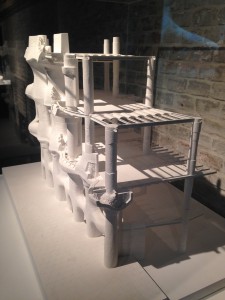
 Part of the exhibition text explained the importance of models to any project Gaudi embarked on:
Part of the exhibition text explained the importance of models to any project Gaudi embarked on:
‘Gaudi put models before plans. For this reason he set up a workshop next to each of his buildings, where he studied and analysed, from as empirical and a craftsman’s point of view, the forms and structures that he later applied to his projects. This is what he called his “experimental method”, a method that is still in use in the Sagrada Familia Workshop although these days this process has been enhanced with the most advanced technological instruments.’ (Daniel Giralt-Miracle, Curator of the Exhibition)
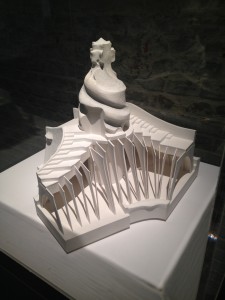 Due to our restricted casting capability in B.15 we will be focusing on the accurate production of the ‘master models’ in a manner suited for molding and casting at the Chatham casting facility. As with all projects, consult myself or Jim as early as possible to achieve the most effective results in your time frame. If the project is too difficult at a later stage a high quality finish will be harder to achieve so don’t hesitate to start on receiving your brief.
Due to our restricted casting capability in B.15 we will be focusing on the accurate production of the ‘master models’ in a manner suited for molding and casting at the Chatham casting facility. As with all projects, consult myself or Jim as early as possible to achieve the most effective results in your time frame. If the project is too difficult at a later stage a high quality finish will be harder to achieve so don’t hesitate to start on receiving your brief.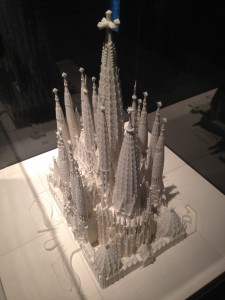 Also on display was this model 3D powder printed model of the entire Sagrada Familia (above). Producing a model of such complexity as a plaster cast would be achievable but in this case the powder printed method was chosen. Most likely due to the sophistication of each ‘spire’ component and it’s relationship to the next. Certainly for the conservation of time and as a retrospective piece this is very appropriate.Â
Also on display was this model 3D powder printed model of the entire Sagrada Familia (above). Producing a model of such complexity as a plaster cast would be achievable but in this case the powder printed method was chosen. Most likely due to the sophistication of each ‘spire’ component and it’s relationship to the next. Certainly for the conservation of time and as a retrospective piece this is very appropriate. 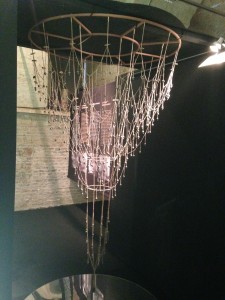 The above prototype testing model or stereo-funicular model is a replica of that used by Gaudi to develop his design for the construction of the crypt of the Colonia Guell. Simple materials like lead weights, string and a frame were crucial aids to design in Gaudis workshops and demonstrate the value of simple methods of creation or problem solving through making.
The above prototype testing model or stereo-funicular model is a replica of that used by Gaudi to develop his design for the construction of the crypt of the Colonia Guell. Simple materials like lead weights, string and a frame were crucial aids to design in Gaudis workshops and demonstrate the value of simple methods of creation or problem solving through making.
I’m glad I was able to catch this exhibition and would recommend anyone to drop by the Architekturzentrum Wien (Vienna) if they are in the city. Although it has now finished you can view the exhibition page here.
Scott
B.15:45 Private View Opening

 After just over a year in the making B.15:45 finally opened on with a private view event on Friday evening. The event was a fantastic success with many unexpected guests and familiar faces gathering to discuss the subject of Modelmaking in Architecture.
After just over a year in the making B.15:45 finally opened on with a private view event on Friday evening. The event was a fantastic success with many unexpected guests and familiar faces gathering to discuss the subject of Modelmaking in Architecture.
An opening introduction speech was made by Professor Nick Dunn who gave a concise description of the history of modelmaking and overview of our goals with this exhibition which was well received by all.
Myself and Jim would like to thank everybody involved and all who made it to the opening to make it such a great success.
The exhibition is now open to all 9.00-17.00 during term time for the next year. We will be hosting several events on alongside the exhibition and engaging with school and college groups which has already begun. Keep checking for updates regarding any public events as we want to keep all interested parties engaged in our continued work.
Many thanks again, Scott and Jim
B.15: 45 Architectural Modelmaking Exhibition
******B.15:45 ENDED IN JULY 2016.*****
*****A NEW EXHIBITION WILL OPEN IN SEPTEMBER 2016!*****
2015 will mark 45 years since the Kantorowich (now Humanities) Building and the B.15 Modelmaking workshop opened its doors to students.
To mark this occasion we have decided to produce a retrospective exhibition to tell the story of those years and give an insight to the changes that have occurred here in terms of approaches to making and design. We will be opening up our archive to display examples of models across the last 5 decades alongside as many stories as we can compile. Whether you know it as ‘The Architecture Workshop’, ‘Ken Peacocks Workshop’, ‘The Modelmaking Workshop’, ‘SED’, ‘SEED B.15’ or ‘Jims Workshop’, B.15 holds many hundreds of memories for staff and students alike.
The exhibition will open from 12th Spetember 2014 and run throughout our 45th year, 2015. Throughout that time we will post a variety of stories and media submitted to us in the lead up to this event.
The exhibition is open to all from 09.00 until 17.00 on week days during term time.
A Platform to Archive
Whilst this exhibition will present a range of making over the last 45 Years here in Manchester we would like to continue to expand our archive and record and even more in depth history of Modelmaking in Architecture. With this in mind we would like to encourage and welcome any further stories or media, physical or digital to keep expanding our heritage collections. If you have any stories, images or models from the history of the university as a whole please get in touch to help us expand our archive and heritage collection.
Please share this link with any groups or alumni that are related to the school to help us expand our archive and heritage understanding:
https://selectsurveys.humanities.manchester.ac.uk/TakeSurvey.aspx?SurveyID=92MH6l42
Many thanks for all of your support so far!
Scott and Jim
B.15:45 ARCHITECTURAL MODELMAKING EXHIBITION – Job Done
At long last we have completed our snapshot look at the past 45 years of the B.15 Modelmaking workshop at the University of Manchester.
It’s been challenging and fascinating taking this from an idea to reality over the last year. We’ve had a lot of fun putting this all together and hope you learn and enjoy it as much as we have.
It goes without saying that there’s a lot of thanks to others for helping us along the way. In particular we’d like to acknowledge Louise & Saul Parker-Backhouse and Paul Thornber who went above an beyond the call of duty to give their time and help us get this fantastic collection on display.
If you’re not joining us this evening for the private view we’ll see you soon to start making exhibits for the next one…
Scott and Jim








